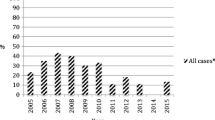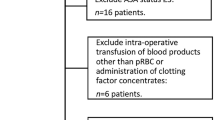Abstract
Purpose
Assess the effect of a protocol of preoperative erythropoietin (EPO) and ferrous sulfate in addition to perioperative tranexamic acid (TXA) on blood transfusions in patients with coronal or metopic craniosynostosis undergoing cranial vault remodeling (CVR) with fronto-orbital advancement (FOA).
Methods
Retrospective review of all coronal and metopic craniosynostosis patients undergoing CVR and FOA from March 2010 to June 2019 was performed. Before 2014 (“Control group”), all patients received blood transfusion at the start of surgery. In 2014, a protocol of preoperative EPO and ferrous sulfate with perioperative TXA and non-automatic transfusion was instituted (“Study group”). Patient demographics and anthropometrics, perioperative hemoglobin (Hb) levels, and transfusion details were collected and compared.
Results
Thirty-six patients met inclusion criteria. Twenty-one patients were in the control group, and 15 in the Study group. Nineteen patients had metopic synostosis, 11 had unicoronal synostosis, and 6 had bicoronal synostosis. There were no significant differences between groups in demographics, operative time, intraoperative crystalloid volume, craniofacial syndromes, or sutures affected. The Study group had higher preoperative Hb (13.9 ± 1.0 vs. 12.6 ± 0.8 g/dL, p < 0.001), lower intraoperative Hb nadir (7.4 ± 1.8 vs. 9.2 ± 1.2 g/dL) lower intraoperative transfusion rate (66.7% vs. 100%, p = 0.008), lower postoperative transfusion rate (0% vs 28.6%, p = 0.03), and exposure to fewer unique units of packed red blood cells (0.7 ± 0.6 vs. 1.5 ± 0.9 units).
Conclusion
Our protocol resulted in decreased transfusion needs. These results add valuable information to the growing body of work on transfusion reduction in craniosynostosis surgery.


Similar content being viewed by others
References
Beno S, Ackery AD, Callum J, Rizoli S (2014) Tranexamic acid in pediatric trauma: why not? Crit Care 18:313
Bergquist CS, Nauta AC, Selden NR, Kuang AA (2016) Age at the time of surgery and maintenance of head size in nonsyndromic sagittal craniosynostosis. Plast Reconstr Surg 137:1557–1565
Bonfield CM, Sharma J, Cochrane DD, Singhal A, Steinbok P (2016) Minimizing blood transfusions in the surgical correction of craniosynostosis: a 10-year single-center experience. Childs Nerv Syst 32:143–151
Carson JL, Grossman BJ, Kleinman S, Tinmouth AT, Marques MB, Fung MK, Holcomb JB, Illoh O, Kaplan LJ, Katz LM, Rao SV, Roback JD, Shander A, Tobian AA, Weinstein R, Swinton McLaughlin L, Djulbegovic B, Clinical Transfusion Medicine Committee of the AABB (2012) Clinical transfusion medicine committee of the AABB: red blood cell transfusion: a clinical practice guideline from the AABB. Ann Intern Med 157:49–58
Pagnoni M, Fadda MT, Spalice A, Amodeo G, Ursitti F, Mitro V, Iannetti G (2014) Surgical timing of craniosynostosis: what to do and when. J Craniomaxillofac Surg 42:513–519
Dadure C, Sauter M, Bringuier S, Bigorre M, Raux O, Rochette A, Canaud N, Capdevila X (2011) Intraoperative tranexamic acid reduces blood transfusion in children undergoing craniosynostosis surgery: a randomized double-blind study. Anesthesiology 114:856–861
Di Rocco F, Arnaud E, Renier D (2009) Evolution in the frequency of nonsyndromic craniosynostosis. J Neurosurg Pediatrics 4:21–25
Di Rocco C, Paternoster G, Caldarelli M, Massimi L, Tamburrini G (2012) Anterior plagiocephaly: epidemiology, clinical findings,diagnosis, and classification. A review. Childs Nerv Syst 28:1413–1422
Engel M, Bodem JP, Busch CJ, Horn D, Mertens C, Hoffmann J, Freudlsperger C (2015) The value of tranexamic acid during fronto-orbital advancement in isolated metopic craniosynostosis. J Craniomaxillofac Surg 43:1239–1243
Engel M, Castrillon-Oberndorfer G, Hoffmann J, Muhling J, Seeberger R, Freudlsperger C (2013) Long-term results in nonsyndromatic unilateral coronal synostosis treated with fronto-orbital advancement. J Craniomaxillofac Surg 41:747–754
Escher PJ, Tu A, Kearney S, Wheelwright M, Petronio J, Kebriaei M, Chinnadurai S, Tibesar RJ (2019) Minimizing transfusion in sagittal craniosynostosis surgery: the Children's Hospital of Minnesota Protocol. Childs Nerv Syst 35:1357–1362
Fearon JA, Weinthal J (2002) The use of recombinant erythropoietin in the reduction of blood transfusion rates in craniosynostosis repair in infants and children. Plast Reconstr Surg 109:2190–2196
Goobie SM, Meier PM, Pereira LM, McGowan FX, Prescilla RP, Scharp LA, Rogers GF, Proctor MR, Meara JG, Soriano SG, Zurakowski D, Sethna NF (2011) Efficacy of tranexamic acid in pediatric craniosynostosis surgery: a double-blind, placebo-controlled trial. Anesthesiology 114:862–871
Goodnough LT, Monk TG, Andriole GL (1997) Erythropoietin therapy. N Engl J Med 336:933–938
Helfaer MA, Carson BS, James CS, Gates J, Della-Lana D, Vander Kolk C (1998) Increased hematocrit and decreased transfusion requirements in children given erythropoietin before undergoing craniofacial surgery. J Neurosurg 88:704–708
Hunt BJ (2015) The current place of tranexamic acid in the management of bleeding. Anaesthesia 70(Suppl 1):50–53 e18
Kolar JC (2011) An epidemiological study of nonsyndromal craniosynostosis. J Craniofac Surg 22:47–49
Kurnik NM, Bristol R, Maneri C, Singhal R, Singh DJ (2017) Open craniosynostosis surgery: effect of early intraoperative blood transfusion on postoperative course. J Craniofac Surg 28:e505–e510
Lavoie J (2011) Blood transfusion risks and alternative strategies in pediatric patients. Paediatr Anaesth 21:14–24
Martin JP, Wang JS, Hanna KR, Stovall MM, Lin KY (2015) Use of tranexamic acid in craniosynostosis surgery. Plast Surg (Oakv) 23:247–251
Meyer P, Renier D, Arnaud E, Jarreau MM, Charron B, Buy E, Buisson C, Barrier G (1993) Blood loss during repair of craniosynostosis. Br J Anaesth 71:854–857
Naran S, Cladis F, Fearon J, Bradley J, Michelotti B, Cooper G, Cray J Jr, Katchikian H, Grunwaldt L, Pollack IF, Losee J (2012) Safety of preoperative erythropoietin in surgical calvarial remodeling: an 8-year retrospective review and analysis. Plast Reconstr Surg 130:305e–310e
Parker RI (2014) Transfusion in critically ill children: indications, risks, and challenges. Crit Care Med 42:675–690
Rothermel LD, Lipman JM (2016) Estimation of blood loss is inaccurate and unreliable. Surgery 160:946–953
Song G, Yang P, Zhu S, Luo E, Feng G, Hu J, Li J, Li Y (2013) Tranexamic acid reducing blood transfusion in children undergoing craniosynostosis surgery. J Craniofac Surg 24:299–303
Steinbok P, Heran N, Hicdonmez T, Cochrane DD, Price A (2004) Minimizing blood transfusions in the surgical correction of coronal and metopic craniosynostosis. Childs Nerv Syst 20:445–452
Steinbok P, Escher PJ, Tu A, Kearney S, Wheelwright M, Petronio J, Kebriaei M, Chinnadurai S, Tibesar RJ (2019, 2020) Minimizing transfusion in sagittal craniosynostosis surgery: the Children's Hospital of Minnesota Protocol. Child's Nervous System, Childs Nerv Syst 35:1357–1362. https://doi.org/10.1007/s00381-019-04393-9
Stricker PA, Fiadjoe JE, Kilbaugh TJ, Pruitt EY, Taylor JA, Bartlett SP, McCloskey JJ (2012) Effect of transfusion guidelines on postoperative transfusion in children undergoing craniofacial reconstruction surgery. Pediatr Crit Care Med 13:e357–e362
Tran DH, Wong GT, Chee YE, Irwin MG (2014) Effectiveness and safety of erythropoiesis-stimulating agent use in the perioperative period. Expert Opin Biol Ther 14:51–61
Velardi F, Di Chirico A, Di Rocco C (1999) Blood salvage in craniosynostosis surgery. Childs Nerv Syst 15:695–710
Velardi F, Di Chirico A, Di Rocco C, Fundaro C, Genovese O, Rendeli C, Menichella G, Serafini R, Piastra M, Viola L, Pietrini D, Pusateri A, Stoppa F (1998) "no allogeneic blood transfusion" protocol for the surgical correction of craniosynostoses. II. Clinical application. Childs Nerv Syst 14:732–739 discussion 740-731
White N, Bayliss S, Moore D (2015) Systematic review of interventions for minimizing perioperative blood transfusion for surgery for craniosynostosis. J Craniofac Surg 26:26–36
Yee ST, Fearon JA, Gosain AK, Timbang MR, Papay FA, Doumit G (2015) Classification and Management of Metopic Craniosynostosis. J Craniofac Surg 26:1812–1817
Author information
Authors and Affiliations
Corresponding author
Ethics declarations
Conflict of interest
The authors declare they have no conflict of interest.
Additional information
Publisher’s note
Springer Nature remains neutral with regard to jurisdictional claims in published maps and institutional affiliations.
Rights and permissions
About this article
Cite this article
Escher, P.J., Tu, A.D., Kearney, S.L. et al. A protocol of situation-dependent transfusion, erythropoietin and tranexamic acid reduces transfusion in fronto-orbital advancement for metopic and coronal craniosynostosis. Childs Nerv Syst 37, 269–276 (2021). https://doi.org/10.1007/s00381-020-04654-y
Received:
Accepted:
Published:
Issue Date:
DOI: https://doi.org/10.1007/s00381-020-04654-y




